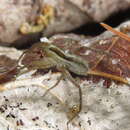Conservation Status
provided by University of Alberta Museums
Poorly known, but not likely to be an issue considering its wide range and frequency of occurrence.
- license
- cc-by-nc
- copyright
- University of Alberta Museums
Cyclicity
provided by University of Alberta Museums
Males are generally found from April to late August, while females are generally found between April and October. Egg sacs are produced between June and October.
- license
- cc-by-nc
- copyright
- University of Alberta Museums
Distribution
provided by University of Alberta Museums
Common throughout southern Canada and the northern U.S.
- license
- cc-by-nc
- copyright
- University of Alberta Museums
General Description
provided by University of Alberta Museums
"Female: Total length 5-6 mm. Cephalothorax (both dorsally and ventrally) and abdomen are generally dark brownish-grey. Stripes on carapace (medial and submarginal) are pale and wide, making it appear that the carapace is light greyish with two dark stripes. Epigynum hood is quite prominent; with a wide, shallow cavity. The median septum is thin at the anterior portion, and rounded at the posterior portion, and flat overall. There are a pair of yellowish stripes that are on either side of the pale heart mark, they merge and meet with the end of the heart mark. Sternum sometimes has mark shaped like a "V".
Male: Total length 4.5 - 5 mm. Pattern is similar to female, but color is generally darker. Large, shiny sclerite on palea near base on embolus. The embolus itself is partially concealed by the median apophysis. Median apophysis has two processes: basal process is small and hooklike, while distal process is flat, curved, bumpy, and quite long. Heart mark is large and fairly vague in comparison to female. In both sexes, eastern specimens tend towards lighter coloration."
- license
- cc-by-nc
- copyright
- University of Alberta Museums
Habitat
provided by University of Alberta Museums
Diverse. Fields, forest clearings, and bogs are preferred. Sometimes found in woods, beaches, and dunes.
- license
- cc-by-nc
- copyright
- University of Alberta Museums
Life Cycle
provided by University of Alberta Museums
"Pardosa distincta is quite common over most of its range, and shows up frequently in pitfall traps. Like all wolf spiders, it is an opportunistic ambush predator. Though it chases down its prey over short distances, P. distincta does not actively seek out its prey; rather, it waits for its prey to draw close to it - then strikes in a burst of speed. Prey is detected by visual stimuli, primarily by the large anterior median eyes. Webbing is not used in prey capture, but is used for draglines, nest lining, and the construction of egg cases. Full maturity evidently takes about two years. Juveniles overwinter, grow the following season, overwinter again, and reach adulthood the following summer. Mating is precipitated by a visual display on the part of the male, and usually lasts about 15 minutes. Egg sacs are constructed from two separate halves that are attached to one another, hence its squashed-sphere shape. The egg sac is carried by the female for a few weeks, attached to her spinnerets, until such point as the juveniles are old enough to emerge, at which point she perforates it with her chelicerae to allow them to escape. The hatchlings clamber onto her abdomen and remain there for up to two weeks as they absorb their yolk sacs, clinging to specialized setae. The female's appetite is somewhat suppressed during this period, no doubt to reduce cannibalism!
Pardosa distincta have been observed feeding at temperatures below 10° Celsius in the wild, primarily upon collembolans and other cryotolerant prey. It may be that this is part of the reason whyit is relatively common - its tolerance for low temperatures allows it to remain active and obtain sustenance when other arthropods go torpid."
- license
- cc-by-nc
- copyright
- University of Alberta Museums
Trophic Strategy
provided by University of Alberta Museums
Ambush predator of a wide variety of terrestrial arthropods.
- license
- cc-by-nc
- copyright
- University of Alberta Museums
Pardosa distincta
provided by wikipedia EN
- license
- cc-by-sa-3.0
- copyright
- Wikipedia authors and editors
Pardosa distincta: Brief Summary
provided by wikipedia EN
Pardosa distincta is a species of wolf spider in the family Lycosidae. It is found in the United States and Canada.
- license
- cc-by-sa-3.0
- copyright
- Wikipedia authors and editors

